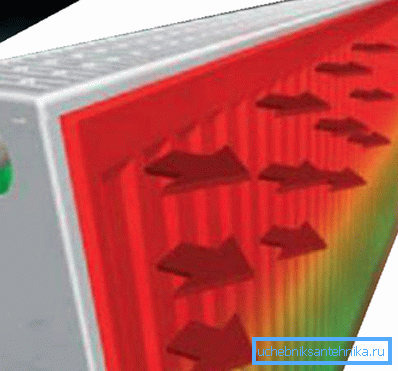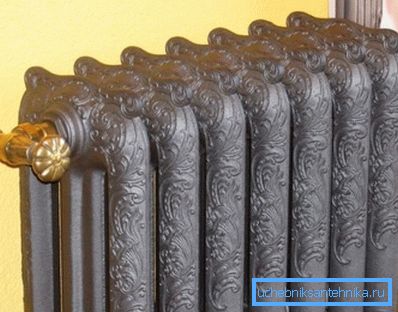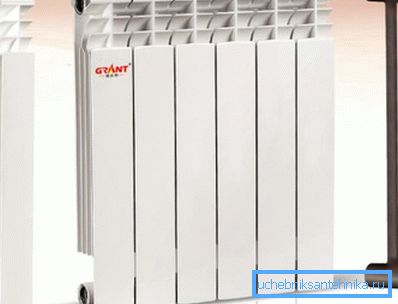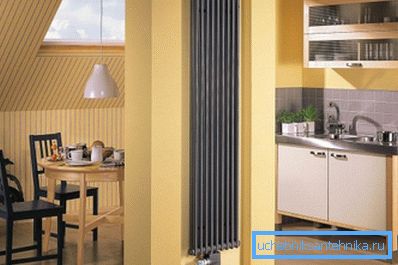Radiator batteries: classification, features of solid and
With the onset of cold weather, the issue of home heating becomes particularly relevant. Given the variety of models of radiators, choosing a suitable heating device is not difficult. To make the right choice, you need at least in general terms to know the features of work, as well as the strengths and weaknesses of each type of device.

Radiator or convector
Many people use the term “radiator-radiator” as synonyms, sometimes convectors are called ordinary radiators, this is not entirely true.
The name of the heating device depends on the principle of its operation, it is possible to identify such heaters as:
- radiators - in them most of the energy is transferred to the room in the form of heat (about 80%). Such devices are interesting because they can work with any temperature of the coolant, a classic representative of heating devices of this class is a thick cast-iron battery;

- in convectors, thermal energy is about 20%, and the rest is due to convective heat transfer;

- Combined devices - these include many modern radiators (for example, bimetallic). They have an approximate equality of heat transfer due to convection and by transfer of heat energy.

It is impossible to say that one of the mentioned methods is better, and another is worse, you just need to understand the difference between the heating devices. Modern aluminum batteries, so popular in everyday life, belong to type 3, heat energy is radiated by the front panel, and convection is provided by the geometry of the fins (cold air gets from the bottom side, and heated comes out from above).
Classification of radiators
It is most convenient to classify heating devices according to the material used for the production.
On sale you can find:
- still not lost popularity cast iron radiators, heating, battery heating. This is a classic sectional massive battery that can last up to 50 years, or even longer. It warms up slowly enough, but it cools down just as slowly. Instead of standard unsightly batteries, you can buy beautiful models with a pattern on the surface;

Note! Of the features of cast-iron radiators, it is possible to note the low resistance to hydraulic shocks. The result may be a metal crack (cast iron in tension does not practically work).
- steel - quite durable, can be produced as solid (panel), and sectional. Also registers can be constructed from steel pipes - structures made from pipes of different diameters through which coolant will circulate, such a heating device looks very unusual. Steel metal is durable and well tolerates dynamic effects;

- bimetallic devices combine 2 types of metal - usually it is steel + aluminum or copper + aluminum. In cheaper devices, a steel frame (horizontal and vertical tubes) with aluminum fins is used, but a copper-aluminum radiator can also be purchased. The price of such batteries is higher than that of cast-iron or steel ones, but also heat transfer with a higher thermal conductivity;

- all-aluminum heating devices the manufacture of a frame (collector tubes) of aluminum alloy, and the ribs are made of aluminum. For additional protection from the inside, the surface of the collector tubes is covered with a protective layer;
- copper batteries look great, in addition, copper has a maximum thermal conductivity and is not subject to corrosion. It is a very soft metal, so it doesn’t frighten water hammer. The heating system looks very unusual, using not only copper heating devices, but also copper pipes.
What you need to know when buying
The radiator radiator, of course, must fit into the interior of the room, but still the main criterion for the selection should be its technical characteristics, and the design features should be taken into account. So on this issue is to stay separately.
Solid or sectional heaters better
Most of the batteries used in everyday life belong to the sectional group. That is, the factory produces standard segments, which are then combined into a heating radiator. The assembly is carried out using a nipple with different threads on both sides. When turning it, both sections are very tightly pressed to each other.

Among the drawbacks of such structures, it is possible to note the risk of leakage at the junction of individual sections. It is also undesirable to use them in autonomous systems with increased pressure.
But you can add, or vice versa, remove unnecessary sections, thereby regulating the heating power of the heater. And you can do it yourself.
In the case of one-piece radiators, the collector is made from a single pipe, and then the fins are pressed onto it. Thanks to this design, it can withstand more pressure in the heating system. So it makes sense to choose such a heating device in an autonomous heating system with an elevated coolant temperature.

Note! Regulate heat output by removing / adding sections will not work. So you need to pick up the battery with a margin, and then just install a thermostat at the input.
Dimensions radiators
Installation instructions for the radiator usually provide for its location in the niche under the window, so the choice of size is a matter of responsibility. The main thing with the installation is that the radiator should not be abutting either to the wall or to the floor, and on top of the window sill there should be 5-7 centimeters of free space. If these requirements are not met, then the lion's share of thermal energy will go to the heating of the walls and window sill.

In terms of height, models with an axle spacing of 400–500 mm can be considered the most common (the height of the device is approximately 570 mm).
In addition, on sale you can find:
- very low radiators - used in homes with large windows, where a radiator of normal size would block the view. Bimetallic radiators are produced with a minimum center distance of 200 mm, aluminum - 150 mm, such a "crumb" is suitable even if the windows reach almost to the floor;

- if there is a shortage of free space, a vertical radiator battery will do. From usually it differs a large center distance and a small number of sections. You can install such a heating device in the corner, where usually there is 50 centimeters of free space.

When replacing a radiator-battery in an apartment, the center distance is of particular importance. It is recommended to measure the distance between the flow and return in the apartment and choose a heater with exactly the same center distance.
Note! If desired, you can purchase a radiator with a different distance between the axles of the nipple holes, but then you will have to dilute / reduce the supply and return pipe.
Thermal power of the device
In the question of how to choose radiators radiators, accounting for heat transfer is the most important parameter. To do this, simply read the documentation on the heater. The heat output of either the entire battery or the heat output of a separate section is usually indicated.
The heat transfer value can also be indicated in the radiator marking. For example, the designation MC140 in the marking of a cast-iron model means the heat transfer of one section at 140 W, knowing the number of sections, calculate the heat transfer of the entire heater. The leaders in this parameter can be considered bimetallic batteries, their heat transfer is at 200 watts.

You also need to pay attention to such technical characteristics of radiator heating batteries as the operating pressure in the system, the permissible coolant temperature, and the type of metal. For example, at the contact of steel and aluminum there is intense corrosion of the latter, so that the service life of the heater is reduced significantly.
Summarizing
The correct choice of the heating battery is not only in consideration of the thermal power of the device. In addition, it is necessary to take into account its geometric characteristics and even the compatibility of the metal of the pipes and the radiator itself, only under this condition the heating system will work stably and without failures. The proposed information will help to navigate the abundance of existing heating devices and not to miss when you buy.
The video in this article shows the main nuances of the choice of radiators for the house.